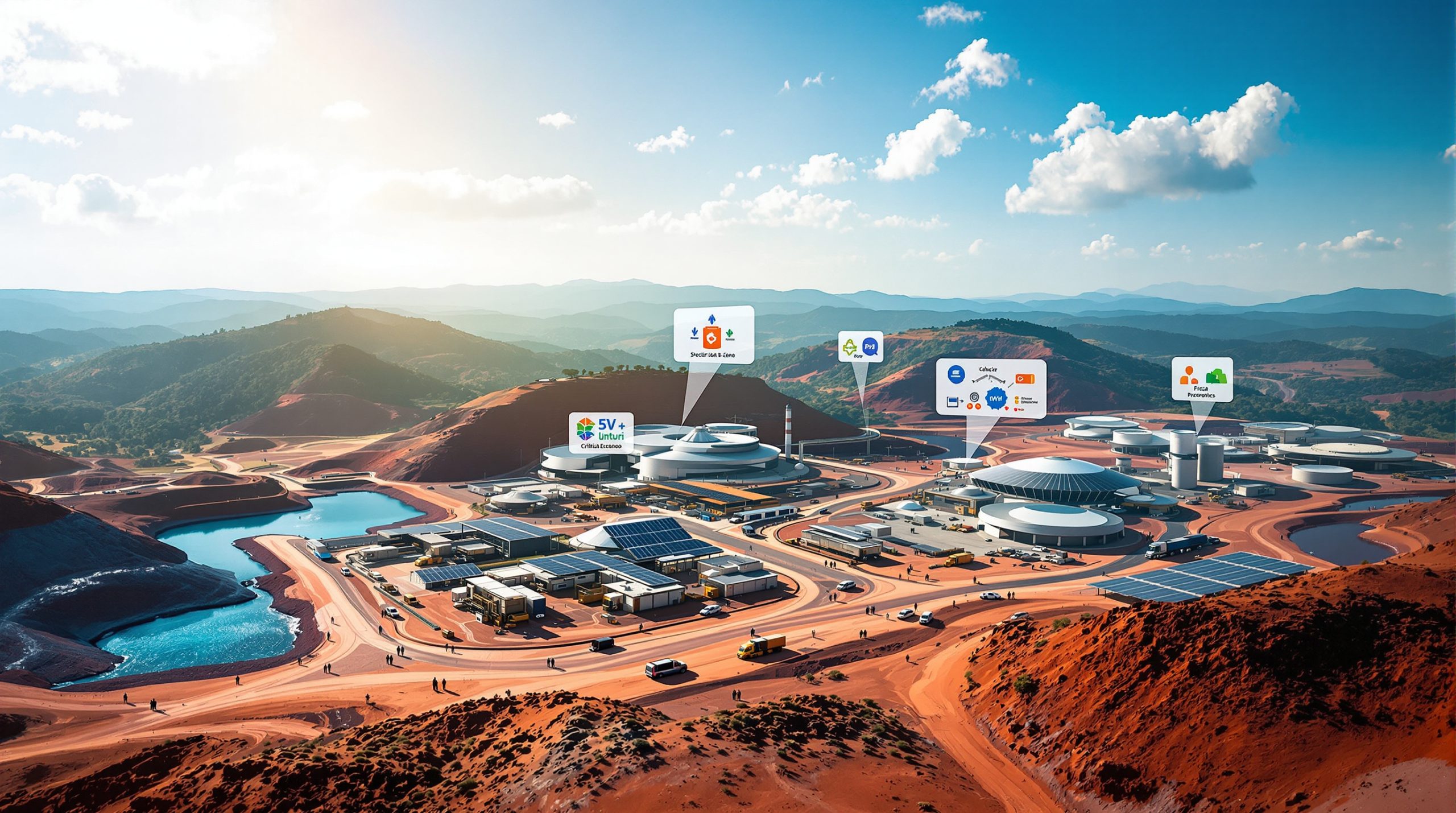How Will South Africa's R2.86 Billion Mining Budget Transform the Sector in 2025?
South Africa's Department of Mineral Resources and Petroleum has received a R2.86 billion allocation for the 2025/26 fiscal year, representing a strategic investment in the country's mining sector during challenging economic times. This comprehensive funding plan aims to address both immediate challenges and long-term transformation goals in one of South Africa's most critical economic sectors.
Budget Allocation Breakdown: Where Will the R2.86 Billion Go?
The R2.86 billion allocation has been strategically divided to support various initiatives and entities within South Africa's mineral resources ecosystem. A significant portion—R1.16 billion, representing 40.55% of the total budget—has been earmarked for transfers to public entities, municipalities, and implementing institutions tasked with executing the department's constitutional mandates.
Minister Gwede Mantashe, addressing Parliament during the Budget Vote 34 presentation, acknowledged the economic constraints while emphasizing the budget's strategic focus: "Although constrained due to prevailing economic hardships, this budget is geared towards enabling the department to efficiently regulate the mining and petroleum sectors for transformation, inclusive growth, and development."
The allocation reflects four key strategic priorities:
- Efficient regulation of mining and petroleum sectors
- Transformation initiatives aimed at inclusive growth
- Sustainable development programs across the sector
- Ensuring equitable distribution of benefits from natural resources
These priorities align with the government's broader economic recovery plan while addressing sector-specific challenges that have emerged in recent years.
What Economic Challenges Is South Africa's Mining Sector Facing?
The mining sector's financial landscape has been particularly challenging, with global economic headwinds creating significant pressure points for South African operations.
"Apart from gold, prices of minerals remain depressed," Minister Mantashe noted during his budget presentation. "The inclusion of diamonds and iron ore in the 30% reciprocal tariffs imposed by the United States threatens our export earnings significantly."
These tariffs come at a particularly difficult time, as export data shows the mining sector generated R674 billion in export earnings—a 0.6% decrease from 2023. This total comprises R586.4 billion from primary minerals and R87.5 billion from processed minerals.
Despite these challenges, the mining sector has shown resilience, with a 0.3% rebound in mining gross value added during 2024, compared to a 0.5% decline in 2023. The sector maintained its contribution of approximately R451 billion to South Africa's GDP, representing about 6% of the total.
Employment trends reveal concerning patterns, with the workforce declining to 484,837 mineworkers—a 0.9% decrease from the previous year's 489,022. Most of these job losses have been concentrated in the platinum group metals (PGM) sector, which continues to struggle with depressed commodity prices.
Mining's Economic Contribution: The Numbers Behind the Industry
Despite the challenging global environment, South Africa's mining sector remains a cornerstone of the national economy. The R451 billion contribution to GDP underscores its continued importance, maintaining a steady 6% share of national economic output despite fluctuations in commodity prices and production volumes.
Export performance tells a complex story: the R674 billion in total export earnings reflects both strengths and vulnerabilities in the sector. The breakdown between primary minerals (R586.4 billion) and processed minerals (R87.5 billion) highlights the ongoing challenge of South Africa beneficiation—adding value to raw materials before export.
This raw-to-processed ratio reveals a key structural challenge: South Africa continues to export significantly more unprocessed minerals than value-added products, limiting potential economic gains and employment opportunities.
The ferroalloy sector crisis provides a stark example of these challenges, with 30 out of 59 chrome furnaces currently shut down or under care and maintenance. This situation not only impacts export revenues but also threatens thousands of high-skilled jobs in the processing sector.
What Legislative Reforms Are Reshaping South Africa's Mining Landscape?
The Department has made significant progress on several key pieces of legislation designed to modernize the regulatory framework governing mining and petroleum activities.
Four major legislative initiatives are currently in various stages of development:
-
Mineral Resources Development Bill (MPRDB): The draft has been finalized and is undergoing stakeholder consultations.
-
Petroleum Products Act (PPA): Review is focused on addressing non-compliance, transformation challenges, and enforcement mechanisms.
-
Upstream Petroleum Resources Development Act (UPRDA): Recently signed by the President, with regulations to be finalized by September 2025.
-
Mine Health and Safety Amendment Bill (MHSA): Currently tabled in Parliament for consideration.
The implementation timeline for these legislative changes shows a careful sequencing approach, with the Petroleum Products Bill scheduled for submission to Cabinet before the end of the current fiscal year. The UPRDA regulations will be completed by September 2025, creating a comprehensive framework for upstream petroleum development.
These legislative developments aim to create regulatory certainty while addressing transformation objectives and enhancing safety standards across the industry. Recent mining permitting insights suggest these reforms could significantly streamline processes for new projects.
How Is the Junior Mining Exploration Fund Stimulating New Discoveries?
One of the most promising initiatives in the budget is the Junior Mining Exploration Fund, which has received a significant boost in funding. The National Treasury has allocated R200 million to the fund, with the Industrial Development Corporation (IDC) providing matching funds, creating a total pool of R400 million dedicated to mineral exploration.
This investment targets a critical gap in South Africa's mining value chain—the discovery of new mineral deposits that could sustain the industry for generations to come. The fund has been specifically designed with transformation objectives in mind, aiming to increase participation by historically disadvantaged South Africans in the junior mining exploration phase of mining.
Complementing this exploration focus is the recently completed Critical Minerals Strategy, developed by Mintek. This comprehensive study covers 21 critical minerals, with detailed reports on each commodity and its strategic importance to South Africa's economy.
The strategy places particular emphasis on five key minerals: platinum, manganese, iron ore, coal, and chrome. These resources have been identified as having significant potential to drive future growth and development in the mining sector.
Why Does Mantashe Call Mining a "Sunrise Industry" Despite Challenges?
Minister Mantashe has consistently challenged the conventional narrative that mining is a "sunset industry" in South Africa. Despite the sector's challenges, he remains bullish on its future prospects.
"With comprehensive geological and mineral insights at our disposal, we are now more convinced than ever that the South African mining industry is a sunrise industry," Mantashe stated during the budget presentation.
This optimistic outlook is based on several factors:
- South Africa's exceptionally rich and diverse mineral endowment
- The strategic importance of many South African minerals for emerging technologies
- The potential for new discoveries through enhanced exploration
- Opportunities for increased beneficiation and value addition
The Critical Minerals Strategy supports this perspective, positioning South Africa to capitalize on growing global demand for minerals essential to renewable energy technologies, electric vehicles, and other high-tech applications.
The designation of mining as a "sunrise industry" represents a significant shift in thinking—moving from viewing mining as a declining legacy sector to recognizing its potential as a driver of future economic growth and development.
What's Being Done to Address the "Pit-to-Port" Export Problem?
One of the most persistent challenges facing South Africa's mining sector is the continued reliance on a "pit-to-port" approach, where raw minerals are extracted and immediately exported with minimal local processing or value addition.
This pattern limits job creation and economic benefits, as the higher-value processing activities occur in overseas markets rather than within South Africa. The crisis in the ferroalloy sector exemplifies this challenge, with 30 out of 59 chrome furnaces currently shut down or under care and maintenance.
The Department is taking several concrete steps to address this issue:
-
Ministerial Task Team: A dedicated team has been established to develop a comprehensive plan for reviving the smelting sector.
-
Potential Export Controls: The government is considering implementing export taxes and quotas for raw minerals to encourage local processing.
-
Electricity Solutions: Reliable and affordable electricity supply has been identified as a critical factor for energy-intensive beneficiation operations.
-
Engagement with Producers: The Department is in ongoing discussions with manganese and chrome producers to develop sustainable solutions for local beneficiation.
These interventions aim to shift the balance from raw mineral exports toward higher-value processed products, creating additional employment opportunities and economic benefits within South Africa.
When Will the New Mining Cadastre System Finally Launch?
The implementation of South Africa's new mining cadastre system—a digital platform for managing mineral rights and licenses—has encountered delays but remains a top priority for the Department.
The system was originally scheduled for launch in the Western Cape in June 2025, but this timeline has been extended by three months. The delay stems from the need to ensure data integrity during the migration from the old system to the new platform.
"We have allocated additional resources to accelerate progress on key project areas including data migration, testing, training, and deployment," Minister Mantashe explained. "The Council for Scientific and Industrial Research (CSIR) has been enlisted to support the implementation process."
The Department has emphasized that the delay is necessary to ensure the accuracy of ownership records and other critical data. Once completed, the cadastre system will represent a significant modernization of South Africa's mineral resource management, bringing greater transparency and efficiency to the licensing process.
The investment in this digital mining systems demonstrates the Department's commitment to addressing administrative bottlenecks that have hampered mining investment in recent years.
How Will This Budget Impact Mining Industry Transformation?
The R2.86 billion allocation includes significant provisions for transformation initiatives aimed at creating a more inclusive and equitable mining sector. These initiatives focus on addressing historical inequalities while promoting sustainable development practices.
A key aspect of the transformation strategy involves promoting local beneficiation of minerals. "This budget enables the creation of value-added products close to the point of production," Minister Mantashe noted, highlighting the connection between beneficiation and transformation goals.
The transformation agenda encompasses several interconnected priorities:
- Supporting sustainable mining practices that benefit local communities
- Creating value-added products near production points to maximize local economic impacts
- Addressing historical inequalities in ownership and participation
- Building skills and capacity within historically disadvantaged communities
These initiatives align with South Africa's broader economic transformation objectives while addressing mining-specific challenges and opportunities.
What Does the Future Hold for South Africa's Mining Industry?
Looking ahead, the Department's strategic vision positions mining as a growth sector with significant potential to drive economic development. This vision balances regulatory oversight with the need to attract investment and stimulate exploration.
"We remain fully committed to modernising and improving mineral resource management," Minister Mantashe affirmed, signaling ongoing efforts to enhance the sector's efficiency and competitiveness.
Key elements of this future outlook include:
- Finalizing and implementing key legislation and regulations to create policy certainty
- Completing the modernization of licensing systems to improve administrative efficiency
- Supporting exploration activities to discover new mineral deposits
- Promoting local beneficiation and value addition to maximize economic benefits
- Focusing on critical minerals essential for future technologies
The Department's approach recognizes both the challenges and opportunities facing South Africa's mining sector, with a strategic focus on positioning the industry for sustainable growth despite current market difficulties. The budget allocation aligns with broader industry evolution trends showing increased emphasis on digitalization and sustainability.
According to the South African Department of Mineral Resources and Energy, this strategic investment represents one of the most significant commitments to the sector in recent years.
FAQ: South Africa's Mining Budget Allocation
How does the current R2.86 billion budget compare to previous years?
While specific year-over-year comparisons weren't provided, Minister Mantashe acknowledged the budget is "constrained due to prevailing economic hardships" but strategically focused on enabling efficient regulation and sustainable development within the mining and petroleum sectors.
What specific minerals are considered critical in South Africa's strategy?
South Africa's critical minerals strategy identifies platinum, manganese, iron ore, coal, and chrome as playing vital roles in the country's mining future. Mintek has completed comprehensive reports on 21 critical minerals in total, analyzing their strategic importance and development potential.
How is the government addressing electricity challenges for mining operations?
The budget allocation includes initiatives to ensure consistent, reliable, and affordable electricity supply, particularly for energy-intensive operations like smelting and beneficiation facilities. This is especially crucial for reviving the 30 chrome furnaces currently shut down or under care and maintenance.
What is the timeline for implementing the new mining cadastre system?
Originally scheduled for June 2025 launch in the Western Cape, the implementation has been delayed by three months to ensure data integrity during migration from the old system to the new platform. Additional resources have been allocated to accelerate progress, including support from the Council for Scientific and Industrial Research (CSIR).
Ready to Spot the Next Major Mineral Discovery?
Discover why historic ASX mineral discoveries can lead to exceptional returns by exploring Discovery Alert's proprietary Discovery IQ model, which delivers real-time alerts on significant mineral announcements across all commodities. Visit our dedicated discoveries page to see how timely insights have created substantial opportunities for informed investors.




